Choosing the Best H55/H57 Motherboard, Part 2
by Rajinder Gill on February 22, 2010 2:00 AM EST- Posted in
- Motherboards
BIOSTAR TH55XE
BIOSTAR TH55XE is currently priced at $115 on Newegg and other online retailers. A $115 MSRP puts the TH55XE smack in the middle of the H55 playing field where competition is fierce from the likes of Gigabyte and ASUS. In fact, BIOSTAR are on the ropes because ASUS and Gigabyte are offering USB3 on their boards around this price point.
| BIOSTAR TH55XE | |
| Market Segment | H55 General Use/HTPC |
| CPU Interface | LGA-1156 |
| CPU Support | LGA-1156 i3/i5/i7 Series of Processors |
| Chipset | Intel H55 Express Chipset |
| BCLK Speeds | 100-800MHz in 1MHz increments |
| DDR3 Memory Speed | 800, 1067, 1333 Frequency Ratios |
| QPI Frequency | All supported mutlpier ratios available |
| Core Voltage | Stock VID ~ +1.26V in 0.02V increments CPU undervoltage offered Stock VID -0.02V ~ -0.08V in 0.02V increments |
| CPU Vdroop Compensation | Enabled/Disabled |
| CPU Clock Multiplier | Dependant on Processor, all available multipliers supported |
| DRAM Voltage DDR3 | Auto, 1.30V ~ 1.55VV in 0.05V ~ 0.1V increments, then 1.50V ~ 2.545V in 0.015V increments (1.50V base) |
| DRAM Timing Control | tCL, tRCD, tRP, tRAS, + 8 Additional Timings |
| DRAM Command Rate | Auto, 1N and 2N |
| PCH Voltage | Auto, 1.10V ~ 1.25V in .05V increments, 1.05V Base |
| CPU VTT (Uncore) Voltage | 1.15V ~ 2.08V in 0.015V increments |
| CPU PLL Voltage | 1.1V ~ 2.03V in 0.15V increments, 1.81V Base |
| IGD VID | Stock VID ~ +0.6V in 0.02V increments |
| Memory Slots | Four 240-pin DDR3 DIMM Slots Dual-Channel Configuration Regular Unbuffered DDR3 Memory to 16GB Total |
| Expansion Slots | 1 x PCI-E 2.0 x16 Slot 1 x PCI-E 2.0 x4 Slot (running at x4, 2.5GT/s) 2 x PCI slot |
| Onboard SATA/RAID | 5 x SATA 3.0GB/s (Support NCQ, AHCI and Hot Plug) 1 x eSATA on Rear I/O |
| Onboard USB 2.0 | 10 USB 2.0 ports (6) I/O Panel, 6 via brackets |
| Onboard LAN | 1 x Realtek 8111DL Gigabit LAN (PCI-E x1) |
| Onboard Audio | Realtek ALC888 - 7.1 Channel HD Audio |
| Other Onboard Connectors | 1 x Print Port, 1 x Serial Port, 1 x FP Audio, 1 x Front Panel, 1 x 1394, 1 x IDE (JMB368), 1 x Power Switch, 1 x Reset Button |
| Power Connectors | ATX 24-pin, 8-pin EPS 12V |
| I/O Panel | 1 x PS/2 Keyboard 1 x PS/2 Mouse 1 x RJ45 4 x USB 2.0/1.1 1 x eSATA 1 x 1394 (LSI FW 322) 1 x Optical Toslink 1 x DVI-D 1 x HDMI 1 x VGA/D-sub 6 Audio I/O jacks |
| Fan Headers | 1 CPU + 2 Additional Headers |
| Fan Control | Full temp/speed fan control for CPU header via BIOS or OS software No speed control for SYS Fans |
| Package Contents | 3 x SATA Cables, 1 x SATA Power Cable, 1 x User Guide, 1 x Driver/software DVD, 1 x I/O Shield |
| Board/BIOS Revisions Used | Board Rev: Ver 5.0 BIOS Files Used: H55AA107.BST |
| Form Factor | uATX (9.6 in. x 9.6 in.) |
| Warranty | 3 Years (First two years = parts and labor; third year = parts only) |
BIOSTAR's feature set is similar to ASRock's H55M-Pro in almost every way, although ASRock managed to cram a TPM header onto their board which costs less. Other than that, you get a slightly more "expensive" 4-phase VRM solution on the BIOSTAR board courtesy of MOSFETs from International Rectifier topped off with heatsinks to keep the whole shebang cool. At a guess, we'd say that BIOSTAR's implementation is limited to a maximum of around 120 amps or so (30 amps per FET), which seems to be a ballpark figure for most H55/H57 motherboards.
At the component level, you get Realtek's ALC888 for audio and Realtek 8111D LAN—commonly found on most motherboards around the $100-$300 mark. The peripheral package is made up of three SATA cables, one SATA power cable, driver DVD and rear I/O shield. As you're paying a little bit more for fewer features on the TH55XE, the inclusion of a USB bracket would have been appreciated to make use of the internal USB headers, because you've only got four connectors available on the rear I/O panel.
Software

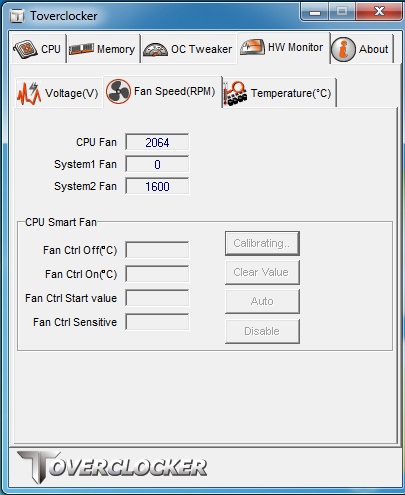
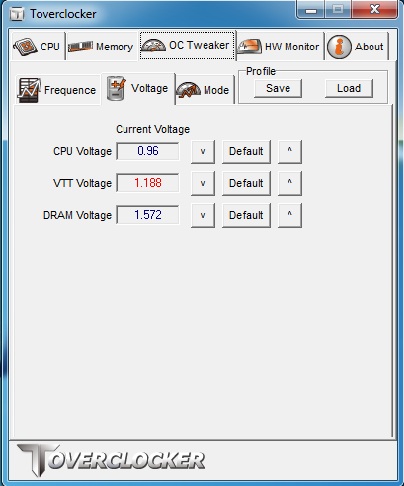
TOVERCLOCKER is included in the software package and allows voltage/bus speed changes, voltage/temperature monitoring, save/load of overclocking profiles and quick-touch overclocking for those who prefer automated methods. The system runs a quick stability test, ramps bus frequencies and repeats this process until the system crashes. Upon reboot the highest stable frequency is automatically selected and applied. Although the utility works, using the "V12" BIOS preset actually gave us a higher stable overclock (3.9GHz vs. 3.75GHz) than the automated tuning function, so we'd encourage you to delve into the "V" presets or manual overclocking instead.
BIOSTAR also includes a power saving utility called GPU (Green Power Utility) that works by shutting down PWM phases during light load conditions. Four performance related presets are available for use, although we did not notice much of a difference in power draw between the settings because Intel's CPUs draw so little power in light load conditions when C-states and SpeedStep are enabled in the BIOS. Power savings from phase shut-off are more apparent on boards that have higher phase counts and switching frequencies because you're contending against greater switching losses.
The Board
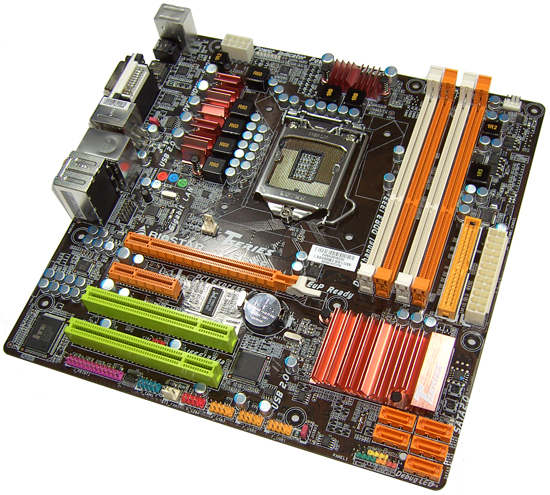
Motherboard layouts follows a similar story for most of the boards on test today, with most ports and connectors remaining within reach in commonly used configurations. One area where BIOSTAR seem to have gotten it wrong is in the placement of the PCI-E x4 slot on the TH55XE. It's placed directly below the x16 PEG slot, leaving no chance of using it if you decided to go with a discrete GPU. We're not fans of BIOSTAR's choice of PCI-E retention latches either, it can be very difficult to remove a graphics card for the primary PEG slot because the latch lever is blocked under most graphics card coolers.
Onboard PWM heatsinks are fastened with push-pins and although contact seemed good, we prefer vendors to use screw fittings wherever possible as there are instances where push pins don't seem to provide sufficient down-force for good contact. Everything else is placed in a friendly manner though, and you even get a couple of onboard power/reset buttons for open test beds (although that's an unlikely field of use for this board). Ordinarily, we'd prefer a CMOS battery location at the edge of a motherboard, but BIOSTAR's BIOS recovery routines are so good that we never had to clear CMOS, let alone remove the battery.
Overclocking
Memory overclocking results using the TH55XE are a little mixed. 4GB memory limits using high-end Elpida based modules come in at 188 BCLK (DDR3-1880 MHz):
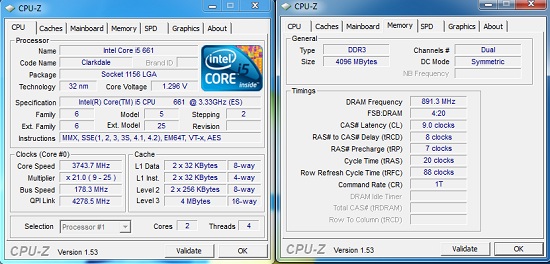
There's a big problem with this overclock though; S3 resume is limited to between 160~165 BCLK using the 2:10 memory ratio with 4GB of memory and a high QPI multiplier, which is a real shame. It's probably something that BIOSTAR can address easily enough, but let's just say the TH55XE is not competitive in this department at present.
8GB memory overclocking results using the 2:10 memory ratio come in a little lower than boards from ASUS and Gigabyte. We topped out at DDR3-1510MHz for absolute stability:
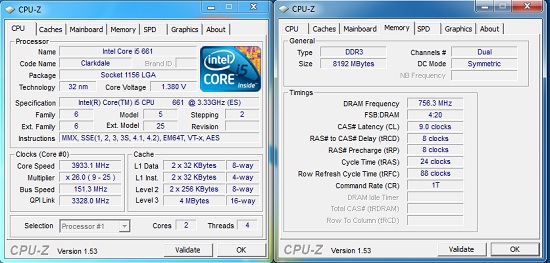
We did try a combination of 200 BCLK and the 2:8 memory ratio (DDR3-1600MHz), but did not manage to find complete stability. The Gigabyte H55M-USB3 managed to pass all of our tests with ease at the same settings.
BIOS
BIOSTAR's O.N.E menu (Overclocking Navigator Engine) is where all the action takes place with a wide variety of adjustments including the CPU Core, PLL, VTT, PCH, IGP and VDimm. Clock generator skew adjustments are also available for maximum BCLK overclocking. Overclocking profiles can be saved, loaded and individually named in one of the available 10 slots. A built in BIOS flashing function is available (by pressing F12 at boot), allowing users to save and flash the BIOS from a USB or HDD easily.
Like other vendors, BIOSTAR's DRAM timing menu needs some work. Individual sub-timings lack the option of AUTO settings. To date, ASUS and Gigabyte are the only vendors providing selective automation of DRAM sub-timing functions on their H55/H57 motherboards. This is a big plus point for users that don't understand advanced DRAM timings but want to tinker with adjustments gradually.
Recovery from failed overclock settings is excellent; this is one area where BIOSTAR are the best in the business. We did not have to clear CMOS or power down the board at all to get it to recover from a failed overclock; no other vendor seems to get this area of functionality completely right.
A selection of three automated overclocking presets are also available, taking CPUs up to 145 BCLK using conservative voltage increases and memory timings allowing for a quick stable overclock without having to get down and dirty with a multitude of BIOS settings.
Fan control is only available for the CPU fan header (via BIOS/TOVERCLOCKER/TPower), offering full temperature range and speed control. Unfortunately, the SYS fan headers cannot be controlled at all and remain "full-on" all the time.






















56 Comments
View All Comments
jackylman - Monday, February 22, 2010 - link
First, thank you for the detailed information on fan control. I've made a few comments about that in the past and it's nice to see that category now seems to be part of a standard Atech mobo review.I'm not in the market for a Clarkdale platform, but if I was, this article would be very useful.
Shadowmaster625 - Monday, February 22, 2010 - link
A lot of people are talking about new motherboards being released before they are ready. And for good reason. Why bother? Why not go and buy a well known and well established motherboard like the GIGABYTE GA-G31M-ES2L for $45 and drop in a E5200 and a quiet GT 220 or 5450? Overclock it to a modest 3 GHz and it will surely smoke this H55/H57 garbage in all the gaming benchmarks, for a LOT cheaper.I do not understand the value in this entire product line. Why do you not compare these with the option I just mentioned? I dont care about how intel wastes their monopoly advantage. If hardware from a year ago is cheaper and better than this crap they are shoveling out now, then it is your responsibility to tell us that.
TrackSmart - Tuesday, February 23, 2010 - link
Point taken, but as readers, isn't it great that we don't have to buy all the newest, most expensive hardware to find out how it runs? And the problems with it? We can just read articles like this one.The Anandtech folks *do* write articles showing budget parts that offer exceptional value (via overclocking or unlocking cores). This just isn't one of those articles.
Rajinder Gill - Monday, February 22, 2010 - link
Hi,I think the E5300 was benchmarked against Clarkdale here in our chipset/CPU launch articles.
http://www.anandtech.com/cpuchipsets/showdoc.aspx?...">http://www.anandtech.com/cpuchipsets/showdoc.aspx?...
regards
Raja
Taft12 - Monday, February 22, 2010 - link
Interestingly, a tasty OC on an E5300 will push the benches up towards the E8600 in those charts, that is to say, faster than Clarkdale.OK, so an E5300 won't get quite THAT far, but it shows you that Clarkdale is marginally better than Wolfdale at best and not at all worth the price.
lukeevanssi - Saturday, June 26, 2010 - link
if anybody want to know more about it so plz visit this link:-http://www.healthproductreviewers.com/force-factor...
there is a lot off knowledge about this product
TrackSmart - Monday, February 22, 2010 - link
Thank you for pushing Gigabyte on the AHCI issue! Can you ask them about their 790-series boards, too? I'm frustrated with the lack of AHCI support on my new GA-790-XTA-UD4 motherboard. There's a 30-45 second delay in initializing SATA hard disks when returning from sleep mode. This causes Windows 7 to blue screen. The only fix is to revert to IDE mode for all drives. I wasted 2 days trouble-shooting this only to find out its an unaddressed problem with AHCI support on this motherboard (and many others).Lukas - Monday, February 22, 2010 - link
This may not be the solution you're looking for, but it fixes the bluescreen at least:http://support.microsoft.com/kb/977178/#top">http://support.microsoft.com/kb/977178/#top
TrackSmart - Monday, February 22, 2010 - link
Thank you for the tip. I tried the hotfix.It's funny because the hotfix definitely prevents total operating system failure (i.e. BSOD). However, Windows takes up to a full minute to become responsive when resuming from sleep mode. Presumably the OS is waiting as long as it needs to for the SATA boot drive to become responsive again.
I will continue running in Native IDE mode for now, since losing 1% system performance is less irritating than waiting forever for my system to become responsive.
*** It would be nice if AMD or Gigabyte addressed the true problem, but I won't hold my breath. I still haven't heard back from their customer support about this problem and it's been a few days. Not even a "we'll get back to you soon" message. Nada.
Taft12 - Monday, February 22, 2010 - link
Great article Raja, I also appreciate the detail of the good and bad!I have a question for you or anyone else who might know - you mentioned ASUS dropping the MSRP of their H55 board at the start of the article... Where can I look up what the different vendors MSRP's are? Intel and AMD have made it quite easy to find out the 1K unit price of their CPUs on their own sites, but I haven't seen anything similar for motherboard vendors. Is there an authoritative, frequently-updated source?